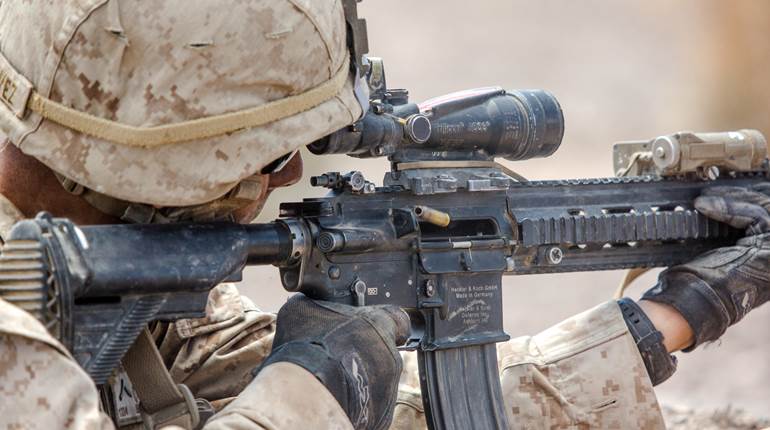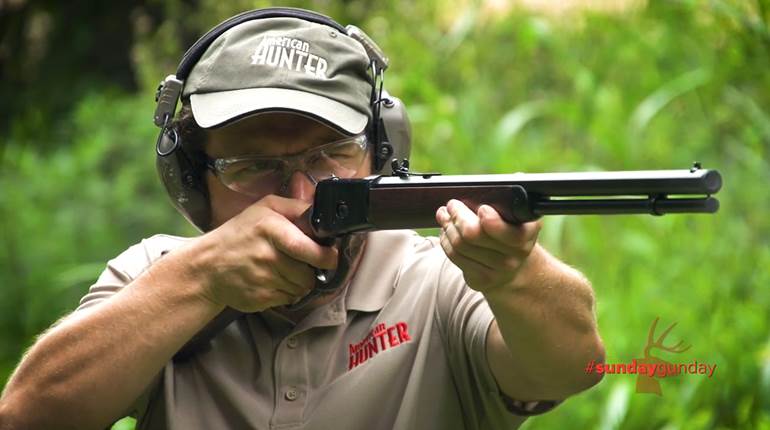
Photos courtesy of Rock Island Auction
When the cargo ship SS Finnmerchant docked at Alexandria, Va., in February 1959, there were 801 Lewis light machine guns on board the ship—in addition to more than 50 pieces of artillery. The artillery included everything from light anti-artillery guns to 60-lb. siege guns, along with their limber/caissons, ammunition and spare parts. There were also more machine guns than just the Lewis guns in the lot. The Irish government had sold all of these guns to the International Armaments Corporation (also known as “Interarms” or “Interarmco”) as scrap metal, and the shipment also contained a potentially significant piece of Irish military history.
The Lewis light machine gun dates back to the early years of the 20th century, when Col. Isaac Newton Lewis, formerly of the U.S. Army’s Ordnance Corps, capitalized on the experimental drum-fed, air-cooled, McLean machine gun, developing a light machine gun that he hoped to sell to the U.S. government. The U.S. Army’s Chief of Ordnance however, Brigadier General William T. Crozier, had a long-standing feud with Lewis and blocked its adoption. The Army and the U.S. Marine Corps thus ended up with an inferior Hotchkiss-made light machine gun, the Benet-Mercie, in 1909. Consequently, Lewis took his design to the Belgians, and by the outbreak of World War I the British government had also decided to adopt this strange looking, but very dependable and portable air-cooled light machine gun in .303 British.
Besides being made in Great Britain during World War I, it was also made for the British war effort by the Savage Arms Company of Utica, New York. In 1916, at the urging of the U.S. Marine Corps machine gun visionary Major Edward B. Cole, the U.S. Navy decided to adopt a .30 caliber (.30-’06) version for its naval landing parties and for the U.S. Marine Corps. Lewis guns were used to great effect around the world during World War I, and they continued in service with some British and American forces into the early years of World War II. The Japanese Army and Navy used several variants of the Lewis gun throughout the war, and some Communist Chinese units were still using captured Japanese Lewis guns in the Korean War.
The 801 Lewis light machine guns that arrived in Alexandria came in their original individual wooden storage crates, with nearly all of them accompanied by at least a spare barrel. The majority of the machine guns did also come with a staggering array of spare parts and accessories however, including bolts, gas cylinders, carrying handles, wrenches (spanners) of several types, strikers (firing pins), anti-aircraft sights, piston rods, spare-parts bags, leather-parts wallets, canvas “hold alls” (tool kits), and magazines. In addition to the Lewis guns, the shipment also included 51 Browning aircraft machine guns and nine heavy water-cooled Vickers machine guns, all with spare parts galore. The original serial numbers of the Lewis guns had been lined through and replaced with a new serial number range of “A-001” through “A-801,” presumably when they were reconditioned at British depots before being transferred to the Irish Free State in 1922 and thereafter. 
There were 13 numbers missing between A-001 and A-801, but nine guns with serial numbers ranging from A-813 to A-861 were included, as well as four guns with only their original serial numbers, that were notin this range: 4713; 5795; 50434; and 57825. Apparently, these four guns were among those Lewis guns captured by the Irish Republican Army during the preceding 1919-1921 War of Independence and were available to the newly established Free State Army. Since it is doubtful that those Volunteers in Munster who formed the anti-Treaty units, or “Irregulars,” during the Irish Civil War would have willingly given up any Lewis guns they had captured prior to June 1921, it is not likely that any of these four guns may have been the one captured at Crossbarry by Tom Barry’s West Cork Flying Column in March 1921. However, the Irish Bureau of Military History’s Witness Statements contain references to at least six Lewis guns being captured or otherwise acquired during the “Tan War,” so these four guns may have been the ones captured by the IRA in Longford, Armagh or Dublin.
According to research conducted in recent years by Frederick “Fritz” Richards, the British government had already furnished the Irish Free State with at least 249 Lewis guns by August 1922, just one month into the Irish Civil War. Much the same as with the re-numbered Short Magazine Lee-Enfield (SMLE) rifles that the British gave to the new Free State Army, the new “A”-prefix numbers would have ensured a system by which the guns could be tracked, were any of these weapons to be found later in Northern Ireland. Unlike the serial numbers on the rifles, which had a fairly convoluted alphabetic prefix to a four digit number (0001-9999), the numbers on the Lewis guns simply started with the most logical letter of the alphabet—“A.” After the Irish Civil War ended in 1923, the Irish Army carried these Lewis guns, and even more guns (thought to total at least 861, judging by the A-prefix serial numbers), through the 1930s, the “Emergency Period” of World War II and into the 1950s, when they were replaced with British BREN light machine guns.
Most of the Lewis guns that arrived at Interarms’ warehouses in Alexandria were then deactivated, in accordance with instructions from the U.S. Treasury Department. Several purchasers have reported a wide difference in the deactivation techniques, as some guns were “hard” welded, while other guns only had a bit of weld in the chamber. Apparently, it simply depended on which technician in an Interarms workshop was performing the “De-Watting” (DEactivated WAr Trophy) process. The program took time, as the guns were not released for sale until 1962. While nearly 600 guns were sold in the local Washington D.C. area, with 587 of them going to Potomac Arms (aka “Hunters’ Lodge”— a nearby retail gun shop on the Alexandria waterfront that specialized in surplus military firearms), more than 200 of the Lewis guns were sold to arms dealers outside the region.
Since quite a few of these 200 or so Lewis guns were sold to Albion Arms in Canada, this led to a mistaken belief among some collectors that the “A” prefix stood for “Albion” and that all of the A-prefix guns had come from the Canadian Army. Other authorities have maintained that the “A” stood for “Aircraft,” but since none of the 801 guns that came into Alexandria from Ireland had been altered for use on an aircraft, or had any aviation-related appendages with them, this conjecture is similarly incorrect. Besides, the guns are all identified with their “A-prefix” numbers on the original shipping documents, which were produced by the Irish government. The “A”-prefix serial number was simply a way to readily track the gun, were it to be later found north of the border in Ulster.
Some of the guns were later legally re-activated by their purchasers for live firing; they, along with the still deactivated guns, are held today in private collections, and museums, throughout the United States and Canada. In fact, it is estimated at least nine out of every 10 Lewis light machine guns that are now in American collections came in this shipment from the Republic of Ireland. Several guns have been used in re-enactments, while others are routinely fired at machine gun competitions in the United States. One of the guns with its original serial number, (serial number 5795), had been made into a training aid cutaway by the Irish Army, and it is now in the study/research collection of the National Museum of the Marine Corps at Quantico, Va. The U.S. Army museum system also has two of the “A”-prefix guns; one (A-670) at the United States Military Academy Museum in West Point, N.Y., and the other one (A-537) at the Museum Clearinghouse Facility in Anniston, Ala.. Interestingly, one of these Lewis guns made its way to a small guesthouse in southern Greece, where it was last seen in 2006. The hotel’s owner related that he had acquired this Lewis gun many, many years ago while on a trip to the United States and, after disassembling the machine gun, he had brought it home with him in his suitcase.
The author thanks Wesley Bourke, Al Houde, Glenn Hyatt, Les Jensen, Mark Keefe, Robert McDonough, Michael J. Parker, Frederick “Fritz” Richards, Michael Shyne, and Paul Smith, for their kind assistance in the preparation of this article.
Additional Reading
The Ivy Patch Gun
"Grim Reapers": The Machine Guns of World War One
A Lewis Gun For the Trenches
I Have This Old Gun: Lewis Machine Gun




































